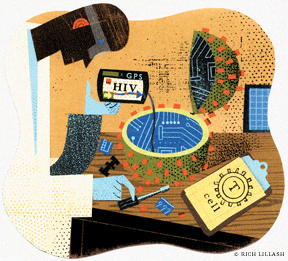
Killer T-Cells for HIV
Penn researchers and colleagues in the UK have engineered T-cells, a key component of the body’s immune system, that are capable of targeting HIV strains that normally elude detection. By isolating several genes that encode a specific group of T-cell receptors, the group produced an ultra-sensitive variant that may be particularly promising for patients with chronic infections for whom antiretroviral drugs fail to work. The study was published online in the journal Nature Medicine.
“The engineered T-cells responded in a much more vigorous fashion [than natural T-cells] so that far fewer T-cells were required to control infection,” said co-senior author James Riley, research associate professor of pathology and laboratory medicine. Lead author Angel Varela-Rohena Gr’07, whose doctoral dissertation focused on the work, added that by using the group’s methodology, “billions of these anti-HIV-1 warriors can be generated in two weeks.” The researchers hope to begin clinical trials later this year.
Adult Stem Cells for Liver Therapy
Patients who have lost the ability to repair liver tissue may have new hope. A research team led by assistant professor of medicine Linda Greenbaum has identified a protein marker called Fox|1 that serves as a telltale signature for rare adult liver stem cells. Using a mouse model of chronic liver damage, the group also showed that these cells are capable of both replenishing the liver and lining the bile duct. The study appeared in the journal Hepatology.
By using the Fox|1 marker to identify these dual-potential stem cells, the researchers hope next to isolate the cells from neighboring tissue and transplant them back into damaged livers to restore function. The molecular events leading up to the expression of Fox|1 remain mysterious, says Greenbaum, but this small advance “has significant implications for cell-replacement therapies of chronic liver disease in the future.”
The Urban Beauty Dividend
For years, the development of leisure venues has dominated city-planning agendas in America. Baseball stadiums, aquariums, riverfront parks: if you build them, advocates say, residents will come.
But do they? According to a study by Wharton real estate professor Albert Saiz and Gerald Carlino of the Federal Reserve Bank of Philadelphia, the answer is a solid, if modest, yes.
Reviewing population data from the 1990s, they concluded that cities blessed with good museums, architectural attractions, and the like gained an extra 2 percent of population during the decade, compared to their homelier counterparts. The effect was particularly helpful to cities that rate low in the weather and taxation departments. Tourism jobs don’t explain the bump, the authors say. Indeed, the availability of jobs in general, while still an important factor for any city’s growth, may not be as crucial as it used to be. Saiz and Carlino found that traditional, business-centric downtown districts often weren’t the biggest factors in attracting new residents. That honor went to what they’ve dubbed “central recreation districts.”
“People are richer now than they were in the mid-20th century,” Saiz observes, “so there’s a focus on ways to make the city more attractive for living and enjoying and for families and leisure.”
—T.P.

